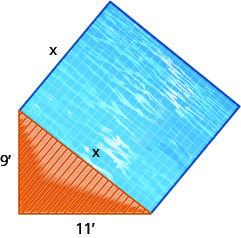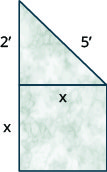9.4E: Exercises
( \newcommand{\kernel}{\mathrm{null}\,}\)
Practice Makes Perfect
Multiply Square Roots
In the following exercises, simplify.
- √2·√8
- (3√3)(2√18)
- Answer
-
- 44
- 18√6
- √6·√6
- (3√2)(2√32)
- √7·√14
- (4√8)(5√8)
- Answer
-
- 7√2
- 160
- √6·√12
- (2√5)(2√10)
(5√2)(3√6)
- Answer
-
30√3
(2√3)(4√6)
(−2√3)(3√18)
- Answer
-
−18√6
(−4√5)(5√10)
(5√6)(−√12)
- Answer
-
−30√2
(6√2)(−√10)
(−2√7)(−2√14)
- Answer
-
28√2
(−2√11)(−4√22)
- (√15y)(√5y3)
- (√2n2)(√18n3)
- Answer
-
- 5y2√3
- 6n2√n
- (√14x3)(√7x3)
- (√3q2)(√48q3)
- (√16y2)(√8y4)
- (√11s6)(√11s)
- Answer
-
- 8y3√2
- 11s3√s
ⓐ (√8x3)(√3x)
ⓑ (√7r)(√7r8)
(2√5b3)(4√15b)
- Answer
-
40b2√3
(√38c5)(√26c3)
(6√3d3)(4√12d5)
- Answer
-
144d4
(2√5b3)(4√15b)
(2√5d6)(3√20d2)
- Answer
-
60d4
(−2√7z3)(3√14z8)
(4√2k5)(−3√32k6)
- Answer
-
−96k5√k
- (√7)2
- (−√15)2
- (√11)2
- (−√21)2
- Answer
-
- 11
- 21
- (√19)2
- (−√5)2
- (√23)2
- (−√3)2
- Answer
-
- 23
- 3
- (4√11)(−3√11)
- (5√3)2
- (2√13)(−9√13)
- (6√5)2
- Answer
-
- −234
- 180
- (−3√12)(−2√6)
- (−4√10)2
- (−7√5)(−3√10)
- (−2√14)2
- Answer
-
- 105√2
- 56
Use Polynomial Multiplication to Multiply Square Roots
In the following exercises, simplify.
- 3(4−√3)
- √2(4−√6)
- 4(6−√11)
- √2(5−√12)
- Answer
-
- 24−4√11
- 5√2−2√6
- 5(3−√7)
- √3(4−√15)
- 7(−2−√11)
- √7(6−√14)
- Answer
-
- −14−7√11
- 6√7−7√2
- √7(5+2√7)
- √5(√10+√18)
- √11(8+4√11)
- √3(√12+√27)
- Answer
-
- 44+8√11
- 15
- √11(−3+4√1)
- √3(√15−√18)
- √2(−5+9√2)
- √7(√3−√21)
- Answer
-
- 18−5√2
- √21−7√3
(8+√3)(2−√3)
(7+√3)(9−√3)
- Answer
-
60+2√3
(8−√2)(3+√2)
(9−√2)(6+√2)
- Answer
-
52+3√2
(3−√7)(5−√7)
(5−√7)(4−√7)
- Answer
-
27−9√7
(1+3√10)(5−2√10)
(7−2√5)(4+9√5)
- Answer
-
−62+55√5
(√3+√10)(√3+2√10)
(√11+√5)(√11+6√5)
- Answer
-
41+7√55
(2√7−5√11)(4√7+9√11)
(4√6+7√13)(8√6−3√13)
- Answer
-
−81+44√78
(5−√u)(3+√u)
(9−√w)(2+√w)
- Answer
-
18+7√w
(7+2√m)(4+9√m)
(6+5√n)(11+3√n)
- Answer
-
66+73√n+15n
- (3+√5)2
- (2−5√3)2
- (4+√11)2
- (3−2√5)2
- Answer
-
- 27+8√11
- 29−12√5
- (9−√6)2
- (10+3√7)2
- (5−√10)2
- (8+3√2)2
- Answer
-
- 35−10√10
- 82+48√2
(3−√5)(3+√5)
(10−√3)(10+√3)
- Answer
-
97
(4+√2)(4−√2)
(7+√10)(7−√10)
- Answer
-
39
(4+9√3)(4−9√3)
(1+8√2)(1−8√2)
- Answer
-
−127
(12−5√5)(12+5√5)
(9−4√3)(9+4√3)
- Answer
-
33
Mixed Practice
In the following exercises, simplify.
√3·√21
(4√6)(−√18)
- Answer
-
−24√3
(−5+√7)(6+√21)
(−5√7)(6√21)
- Answer
-
−210√3
(−4√2)(2√18)
(√35y3)(√7y3)
- Answer
-
7y3√5
(4√12x5)(2√6x3)
(√29)2
- Answer
-
29
(−4√17)(−3√17)
(−4+√17)(−3+√17)
- Answer
-
29−7√17
Everyday Math
A landscaper wants to put a square reflecting pool next to a triangular deck, as shown below. The triangular deck is a right triangle, with legs of length 9 feet and 11 feet, and the pool will be adjacent to the hypotenuse.
- Use the Pythagorean Theorem to find the length of a side of the pool. Round your answer to the nearest tenth of a foot.
- Find the exact area of the pool.

An artist wants to make a small monument in the shape of a square base topped by a right triangle, as shown below. The square base will be adjacent to one leg of the triangle. The other leg of the triangle will measure 2 feet and the hypotenuse will be 5 feet.
- Use the Pythagorean Theorem to find the length of a side of the square base. Round your answer to the nearest tenth of a foot.

- Find the exact area of the face of the square base.
- Answer
-
- 4.6feet
- 21 sq. feet
A square garden will be made with a stone border on one edge. If only 3+√10 feet of stone are available, simplify (3+√10)2 to determine the area of the largest such garden.
A garden will be made so as to contain two square sections, one section with side length √5+√6 yards and one section with side length √2+√3 yards. Simplify (√5+√6)(√2+√3) to determine the total area of the garden.
Suppose a third section will be added to the garden in the previous exercise. The third section is to have a width of √432 feet. Write an expression that gives the total area of the garden.
Writing Exercises
- Explain why (−√n)2 is always positive, for n≥0.
- Explain why −(√n)2 is always negative, for n≥0.
- Answer
-
- when squaring a negative, it becomes a positive
- since the negative is not included in the parenthesis, it is not squared, and remains negative
Use the binomial square pattern to simplify (3+√2)2. Explain all your steps.
Self Check
ⓐ After completing the exercises, use this checklist to evaluate your mastery of the objectives of this section.

ⓑ On a scale of 1–10, how would you rate your mastery of this section in light of your responses on the checklist? How can you improve this?


